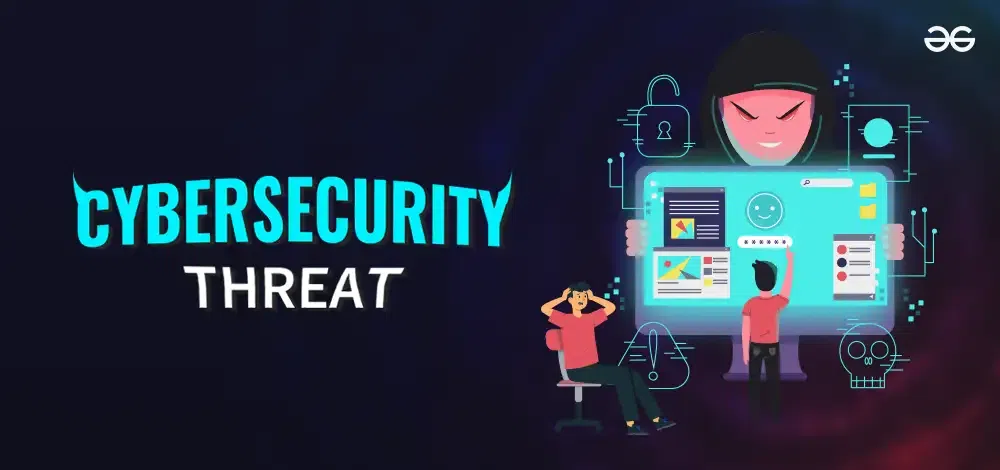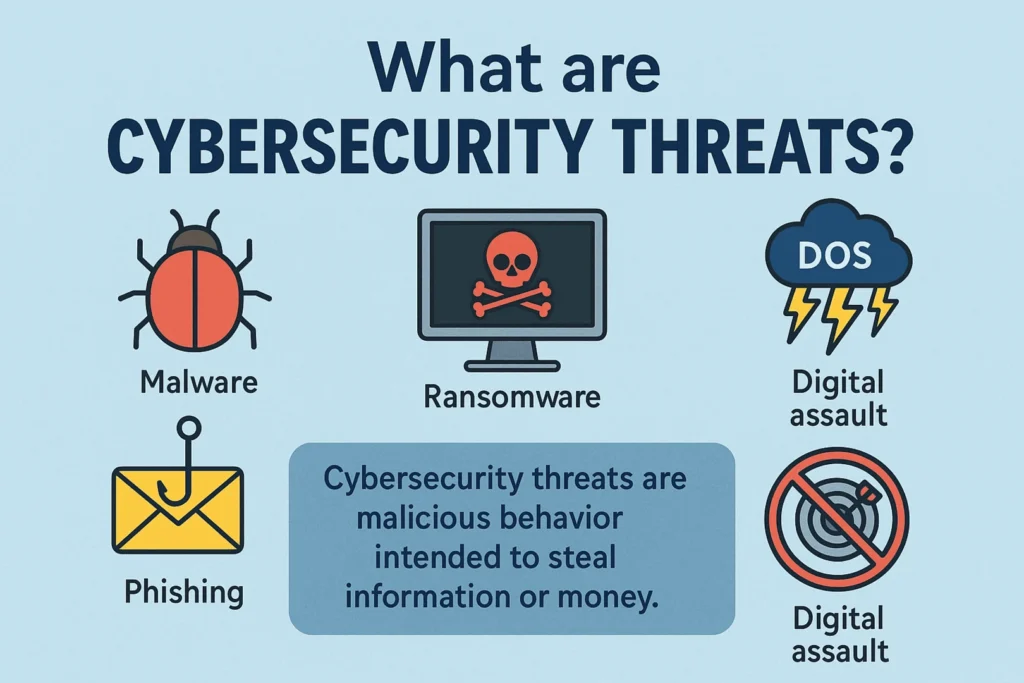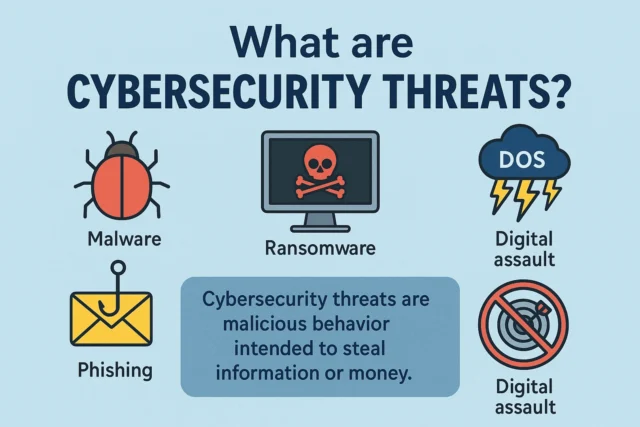As 2025 unfolds, cyber threats are ascending to new heights in scale, complexity, and impact. Organisations and individuals alike face a range of sophisticated risks driven by artificial intelligence (AI), geopolitical tension, ageing software, and evolving attacker tactics. Here’s a deep dive into the Top 10 Cybersecurity Threats in 2025—with actionable guidance to help you stay safe.
Table of Contents

1. AI-Driven Ransomware and Negotiation Bots
Ransomware continues to dominate the threat landscape, but in 2025, it’s evolving. Attackers now deploy AI-powered chatbots to manage victim negotiations, scaling their operations and increasing pressure on victims to pay quickly. Meanwhile, ransomware groups are using double extortion tactics—encrypting your data and threatening to release it publicly unless you pay.
How to stay safe:
- Maintain air‑gapped backups.
- Redundant offline recovery systems.
- Immediate patching strategies and strong phishing awareness.
2. AI-Assisted and AI-Powered Social Engineering
Social engineering is entering a new era. AI helps create ultra-personalised phishing campaigns, spoofed deepfake content, and even synthetic voice or video impersonation. These threats blend psychological manipulation with technical deception, making detection harder than ever.
Mitigation steps:
- Invest in security awareness training.
- Enforce multi-factor authentication (MFA).
- Monitor for unusual behaviour and anomalies in user activity.
3. Nation-State Espionage & Hybrid Cyberattacks
State-affiliated cyber groups—especially from China, Russia, Iran, and North Korea—continue to target governments, critical infrastructure, and key industries. Collaboration between state actors and civilian hackers has increased the scale and sophistication of these threats.
Protection strategies:
- Share threat intelligence across sectors.
- Deploy advanced detection and response tools.
- Strengthen national and corporate cooperation on cyber resilience.

4. Highly Evasive Adaptive Threats (HEAT)
HEAT attacks, such as HTML smuggling and browser-based loaders, evade traditional URL filtering and threat detection tools by using dynamic, obfuscated delivery methods. These are increasingly popular for delivering malware stealthily.
Protect yourself by:
- Deploying behavioural analysis tools.
- Enforcing zero‑trust micro‑segmentation.
- Monitoring browser-based threats in real time.
5. Supply Chain & Third‑Party Vulnerabilities
Attacks on vendor software or third-party services enable attackers to compromise multiple organisations at once. Research shows supply chain weaknesses are cited as the greatest barrier to cyber resilience by 54% of large organisations.
Best practices:
- Vet vendors rigorously.
- Require security attestations and continuous audits.
- Limit third-party access and data rights.
6. Ageing and Unpatched Software Exploits
Research indicates that roughly 32% of cyberattacks exploit unpatched systems or outdated software. In mid‑2025, attackers breached SAP NetWeaver via CVE‑2025‑31324 to deploy the Auto-Colour Linux backdoor, a high‑severity flaw rated 9.8/10.
What you should do:
- Automate patch management.
- Prioritise critical flaws via risk‐based vulnerability scanning.
- Retire legacy systems quickly.
7. Zero‑Trust Failures & Perimeter Weakness
Traditional perimeter defences continue to falter in the face of lateral movement, credential theft, and insider threats. Zero‑trust—where every request is continually verified—is now the gold standard.
Zero‑trust principles:
- Micro‑segment inner networks.
- Use continuous validation of user context.
- Monitor and log all sessions in real time.
8. AI-Amplified DDoS Attacks and Botnet Automation
DDoS attacks are more powerful and accessible than ever, thanks to AI assistants coordinating recon, botnet planning, and multi-vector assault timing using natural language prompts. Even non‑technical attackers can now deploy devastating campaigns.
Defence recommendations:
- Leverage AI‑driven DDoS defence platforms.
- Keep detailed incident response plans at machine speed.
- Share intel with peers and threat feeds.
9. Quantum Decryption Threats & Encryption Harvesting
While full-scale quantum computing remains distant, adversaries are already adopting a “harvest now, decrypt later” approach—stealing encrypted data now to later crack it using quantum methods (e.g., Shor’s algorithm).
To future‑proof your data:
- Begin adopting post‑quantum cryptography.
- Use quantum key distribution (QKD) where practical.
- Plan for cryptographic agility and upgrades.
10. Vulnerability to IoT and Edge Infrastructure Exploits
The widespread deployment of IoT and edge computing in 5G, industrial systems, and smart devices has expanded the attack surface, and many are poorly secured by design. Vulnerabilities in edge nodes can disrupt critical services like healthcare or utilities.
Safety measures:
- Segment IoT devices onto isolated networks.
- Enforce firmware updates and strong authentication.
- Regularly audit and monitor device behaviour.
Building A Resilient Cybersecurity Strategy for 2025
1. Elevate to an AI‑First Defence
Integrate AI-enabled detection, response, and threat hunting tools to keep pace with AI‑equipped attackers. Ensure your own AI tools (APIs, LLMs, operations pipelines) are secured end‑to‑end.
2. Promote Cybersecurity Awareness Culture
The human layer remains battle‑tested. Deliver ongoing training on phishing, social engineering, and AI‑based deception. Simulations remain a strong tool.
3. Implement Zero‑Trust Architecture
Shift from perimeter‑based to zero‑trust models. Employ strict least-privilege access, continuous validation, and micro-segmentation.
4. Prioritise Patch Management & Vendor Monitoring
Critical patching, especially for widely used platforms (like SAP, IoT firmware), must happen immediately. Demand transparency and security from suppliers.
5. Collaborate & Share Intelligence
Engage in public-private partnerships and threat-sharing networks. This is especially vital when facing nation-state or infrastructure attacks.
6. Plan for Post‑Quantum Cybersecurity
Begin migrating to quantum-resistant cryptography. Assess your encryption inventory and build a roadmap for agility as quantum computing advances.

Key Takeaways: Here are the Top 10 Cybersecurity Threats in 2025:
- AI‑driven ransomware & negotiation bots
- AI‑assisted and AI‑powered social engineering
- Nation‑state espionage & hybrid cyberattacks
- HEAT (Highly Evasive Adaptive Threats)
- Supply chain and third‑party breaches
- Ageing, unpatched software exploits
- Zero‑trust and perimeter model failures
- AI‑amplified DDoS attacks
- Quantum decryption threats
- IoT and edge infrastructure vulnerabilities
Your strategic response should include upgraded AI defences, zero-trust adoption, patch and vendor management, threat sharing, training, and preparation for quantum resilience. This layered, forward‑looking posture is the best safeguard in 2025’s high‑stakes digital environment.
Join Our Social Media Channels:
WhatsApp: NaijaEyes
Facebook: NaijaEyes
Twitter: NaijaEyes
Instagram: NaijaEyes
TikTok: NaijaEyes








































